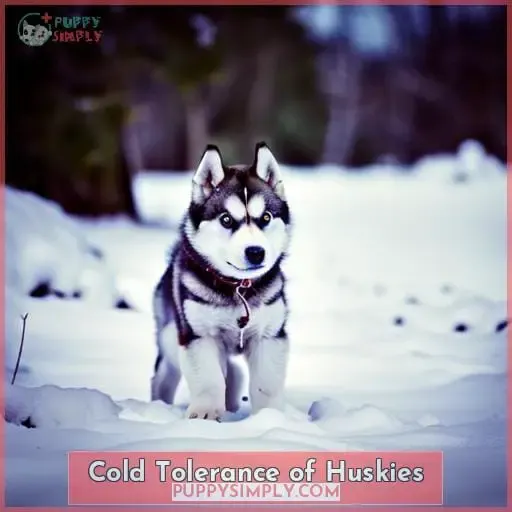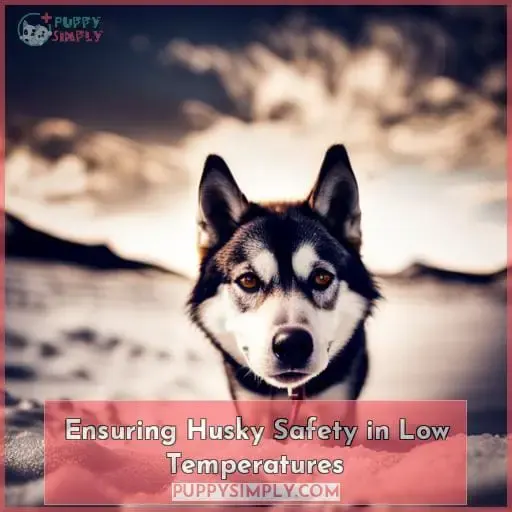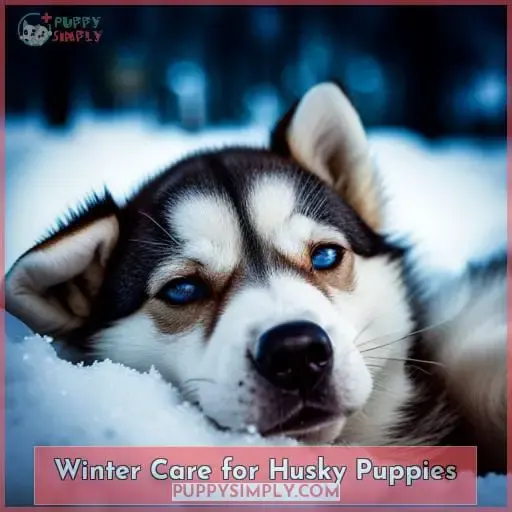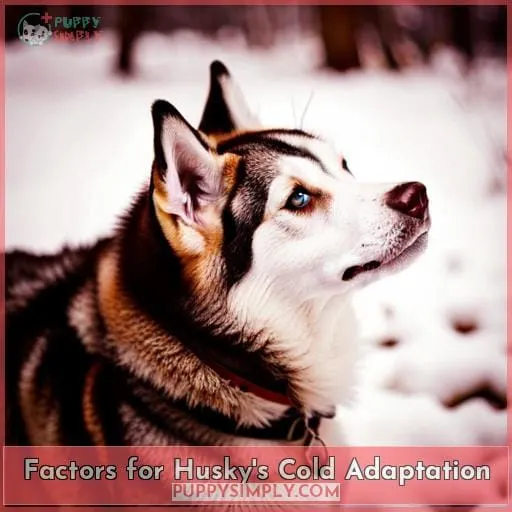This site is supported by our readers. We may earn a commission, at no cost to you, if you purchase through links.
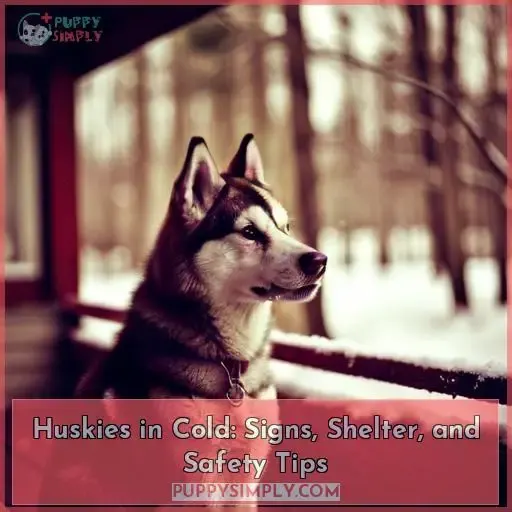 Imagine being a Husky in the freezing cold. It can be tough, but with the right signs to look out for and proper shelter, you can keep your furry friend safe and comfortable.
Imagine being a Husky in the freezing cold. It can be tough, but with the right signs to look out for and proper shelter, you can keep your furry friend safe and comfortable.
In this article, we’ll explore how Huskies handle cold temperatures and provide tips on creating a warm haven for them.
Table Of Contents
Key Takeaways
- Huskies have a double-layered fur that insulates against the cold.
- Huskies may seek indoor shelter when they are cold.
- Huskies need adequate shelter to stay warm in cold weather.
- Husky puppies need extra warmth in cold weather.
Cold Tolerance of Huskies
Huskies can tolerate extremely cold temperatures, such as -75°F (-60°C), due to their remarkable cold adaptation and climate endurance. These resilient dogs have developed survival strategies that allow them to thrive in harsh weather conditions.
With their double-layered fur, consisting of an undercoat for insulation and a top coat for protection against the wind and elements, huskies are well-equipped to handle even the lowest temperatures.
Their natural ability to withstand freezing climates is further enhanced by features like small ears that minimize heat loss and seasonal shedding that helps regulate their body temperature.
However, it’s important to note that while huskies possess impressive weather adaptability, factors such as health condition, age, coat quality,and suitable housing also play a significant role in determining their temperature resilience.
To ensure your husky remains safe during cold weather conditions,having appropriate shelter is crucial.
Consider providing insulated shelters with sturdy construction materials like timber or metal.
Avoid direct ground contact by elevating the structure,and make sure it has strong roofing resistantto snow.
Ideally,the shelter should be sized appropriately,promoting movement yet retaining enough warmth.
Insulation materials,such as straw or hay,could be usedfor sub-zero temperatures.
Blankets may provide sufficient insulation if there’s no snow,but keep them dry.
The addition ofa door can prevent wind,rain,and other animals from enteringthe shelter.
Monitoring changesin howsnow melts onthefurcanindicateyourhusky’s abilitytohandlecoldtemperatures.
Signs of Husky Discomfort in Cold
As a canine behavior specialist, it’s important to recognize the signs of discomfort in Huskies when exposed to cold temperatures.
One common sign is seeking indoor shelter, as they instinctively seek warmth and protection from the elements.
Shivering is another clear indication that your Husky may be too cold and struggling to maintain their body temperature.
Additionally, pay attention to their body language cues such as hunching with a tucked tail or lifting a paw, which can suggest extreme sensitivity to the cold.
Reduced activity or lethargy may also imply that your Husky finds the weather too chilly for comfort.
Seeking Indoor Shelter
Are you noticing behavioral cues like restlessness or attempts to seek indoor comfort? These signs indicate your Husky might be sensitive to the cold.
Check shelter conditions to ensure their comfort and avoid prolonged outdoor stays.
Shivering
When your Husky experiences discomfort in the cold, shivering often emerges as a clear indicator of their struggle with the temperature. Understanding body language is crucial to identify these signs for their safety in harsh conditions.
Body Language Cues
Watch for subtle cues like:
- Hunching
- Tucked tails
- Lifted paws
These body language signs signal discomfort in your Husky due to cold weather.
Paw Sensitivity
You may notice your Husky’s paws are often sensitive to the cold, often lifting a paw or licking their paws frequently.
- Paw lifting
- Paw licking
- Red, cracked, or bleeding paws
- Frostbite
Reduced Activity
In addition to paw sensitivity, a decrease in activity can also indicate your Husky is too cold.
- Decreased appetite
- Dull coat
- Lethargy
- Increased shivering
- Difficulty walking
| Sign | Possible Cause |
|---|---|
| Decreased appetite | Not enough energy to eat |
| Dull coat | Not enough body heat to produce shine |
| Lethargy | Too cold to move around |
| Increased shivering | Body’s natural response to cold |
| Difficulty walking | Muscles too cold to function properly |
Ensuring Husky Safety in Low Temperatures
To ensure the safety of your Husky in low temperatures, it’s crucial to provide them with adequate shelter.
A well-insulated shelter will help protect them from extreme weather conditions and maintain warmth.
Consider incorporating a shelter door into their housing to further shield them from wind and rain, creating a comfortable environment for your Husky in cold weather.
Providing Adequate Shelter
Providing an adequate shelter is crucial for ensuring your Husky’s safety in low temperatures.
The size of the dog house should allow movement but be small enough for your Husky’s heat to warm the air.
Straw or hay can be effective insulation in sub-zero temperatures, but keep them dry for insulation to be effective.
A shelter door can prevent wind and rain, aiding in maintaining a warm environment for the Husky.
Shelter Insulation
Shelter insulation is crucial for a Husky’s ability to endure low temperatures.
The size of the dog house should allow movement but small enough for your Husky’s heat to warm the air.
Straw or hay can be effective insulation in sub-zero temperatures.
Blankets are suitable if it doesn’t snow, but keep them dry for insulation to be effective.
A shelter door can prevent wind and rain, aiding in maintaining a warm environment for the Husky.
Benefits of Shelter Door
Depending on location and shelter design, a shelter door may not be necessary.
However, a shelter door can prevent direct wind and rain, enhancing warmth inside.
Closing the door significantly contributes to keeping your Husky warm in its house.
Winter Care for Husky Puppies
While adult Huskies can tolerate extreme cold, young puppies lack the same cold tolerance.
Observe your puppy’s behavior for cues like excessive shivering or curling up to determine if they need additional warmth.
Lack of Cold Tolerance
Husky puppies lack the same cold tolerance as adults, so they require extra warmth and monitoring during cold weather.
Observe your husky puppy for behavioral cues like excessive shivering or curling up to stay warm.
Provide a well-insulated shelter with a door to help keep your puppy warm and safe.
Behavioral Cues
Lacking the same cold tolerance as adults, husky puppies display behavioral cues indicating discomfort in the cold.
These include:
- A hunched posture
- Tucked tail
- Ice on fur
- Lifting a paw
- Lethargy
Additional Warmth Needs
As a puppy, you may need to provide extra warmth for your Husky in the form of:
- Dog boots
- Paw protection
- A hot water bottle or foot warmer
- Warm bedding
- Extra blankets
- Straw or hay insulation
- Snuggles, and more.
Factors for Husky’s Cold Adaptation
Huskies are well-adapted to cold weather, with a double coat, small ears, and a preference for snowy blizzard environments.
- Temperature
- Shelter
- Social needs
Natural Adaptation
Huskies withstand extreme cold thanks to their natural adaptation.
Their double coat insulates against cold.
Seasonal shedding regulates temperature.
Small ears minimize heat loss.
Thick fur protects from wind and snow.
Shelter Considerations
In addition to their natural adaptation, providing adequate shelter is crucial for ensuring your Husky’s comfort in cold weather.
The size, shape, materials, location, and doors of the shelter all play a role in keeping your Husky warm and safe.
Social Needs
In addition to shelter considerations, you should also consider your Husky’s social needs when determining whether they’re suited for outdoor living.
Huskies are pack animals with a strong need for companionship. They may experience social anxiety or separation anxiety if they’re left alone for long periods of time.
Huskies that are well-socialized and have plenty of interaction with other dogs are more likely to be comfortable being left alone.
If you’re considering an outdoor Husky, make sure you have the time and resources to provide them with adequate socialization and companionship.
Physical Vulnerabilities
To ensure your Husky’s well-being in cold weather, consider their physical vulnerabilities.
Wet coats put them at risk of frostbite and hypothermia.
Dehydration can occur due to the dryness of winter air.
Take precautions to protect against these dangers by providing adequate shelter, keeping them dry, and ensuring access to water.
| Physical Vulnerabilities |
|---|
| Risk of Frostbite |
| Hypothermia |
| Wet Coat |
Determining Outdoor Suitability
To determine if your Husky can stay outside in the cold, you need to consider factors like:
- Local temperature extremes
- The suitability of your shelter
- The purpose of your Husky
- Companionship considerations
Local Temperature Extremes
Evaluating local temperature extremes is essential for determining whether an outdoor husky is suitable for your household.
Huskies have a cold tolerance range of -60°F to 60°F, but they can still get frostbite if they’re wet or not properly sheltered.
A snow-resistant shelter with proper construction is crucial for keeping your husky safe in cold weather.
Suitable Shelter Criteria
Suitable shelter criteria include:
- The size, insulation, and location of the shelter, as well as the purpose of the Husky.
- The size should allow movement but be small enough to retain heat.
- Insulation materials like straw or hay can be effective in sub-zero temperatures.
- The shelter should be in a sheltered location, away from wind and rain.
Purpose of the Husky
Considering the purpose of your Husky helps determine if they’re suited for outdoor living in cold temperatures.
Working dogs like Huskies may be used to pulling sleds or herding in cold weather, but pet Huskies may not have the same tolerance for extreme temperatures.
Companionship Considerations
In addition to temperature extremes and shelter criteria, the purpose of your husky and its companionship needs are also important factors to consider when determining its outdoor suitability.
- Working huskies may require more exercise than pet huskies.
- Huskies are social animals and may need companionship from other animals or humans.
- Huskies may be happier living indoors with access to a securely fenced yard.
Recommendations for Husky Care
Huskies are well-suited to cold weather, but they still need proper care to stay healthy.
Provide your Husky with:
- A well-insulated shelter
- Plenty of warm bedding
- Access to fresh water
Groom your Husky regularly to remove loose fur and prevent mats.
Puppies need extra warmth and care, so be sure to monitor them closely during cold weather.
Grooming Essentials
Keep your Husky’s coat healthy and free of mats by using a de-shedding tool and slicker brush regularly.
- A slicker brush will help remove loose fur.
- An undercoat rake will help prevent tangles.
- Regular grooming will also help control shedding.
Puppies’ Additional Needs
Puppies lack the same cold tolerance as adult Huskies, so they need extra warmth and monitoring to stay safe in cold weather.
Here are some tips for keeping your Husky puppy warm and comfortable in winter:
- Provide a warm, insulated shelter.
- Monitor your puppy’s behavior for signs of discomfort.
- Offer warm bedding, blankets, or straw inside the shelter.
- Limit outdoor time in extreme cold.
Frequently Asked Questions (FAQs)
What are the signs that a Husky is too cold?
If your Husky is:
- Shivering
- Has ice on its fur
- Lethargic
- Refuses to go outside
It’s too cold for them.
Provide them with a warm, insulated shelter and limit their outdoor time in extreme cold.
What kind of shelter does a Husky need in the winter?
To keep your Husky warm in the winter, provide:
- An insulated shelter with a door
- Dry bedding
- Access to fresh water
What kind of grooming do Huskies need in the winter?
As a canine behavior specialist, I recommend:
- Brushing your Husky’s undercoat daily
- Using a de-shedding tool to remove loose hair
This will help to keep your Husky warm and comfortable during the winter months.
How much exercise should a Husky get in the winter?
Huskies need at least 2 hours of exercise per day, regardless of the weather.
In the winter, keep your Husky’s exercise routine consistent and avoid overexertion, which can lead to hypothermia.
What are some common health problems for Huskies in the winter?
Like snowflakes, no two Huskies are the same – but all share a common love of the cold. However, there are some health problems that Huskies may face during the winter months.
Conclusion
With proper care, your Husky can enjoy the great outdoors during cold weather. By understanding their cold tolerance and providing them with adequate shelter, you can help keep them safe and comfortable all winter long, so they can stay warm and toasty like a baked potato in a campfire.

